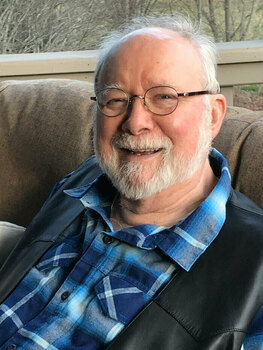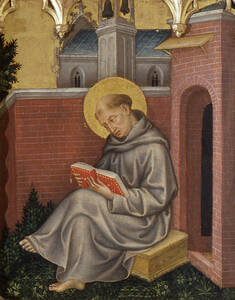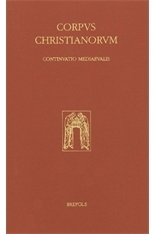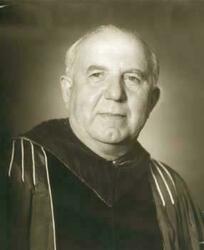Alumni Spotlight: Robert J. Schneider

The Medieval Institute is pleased to present our Fall 2021 Alumni Spotlight. In this series we feature the career paths of Institute alumni. Look for a new installment each semester, and follow our weekly news features regarding Medieval Institute-supported programming, events, guest lectures and general medievalist news on our news and events feed.
This academic year, as the Medieval Institute celebrates 75 years, we are highlighting alumni who can speak to its long and colorful history. Our first spotlight features one of the Medieval Institute’s earliest graduates, Robert J. Schneider (Ph.D., 1965), Distinguished Professor Emeritus of General Studies and Classical Languages at Berea College, Kentucky.
For his doctoral dissertation at the MI, he produced a critical edition of Vincent of Beauvais’ De morali principis institutione under the direction of Rt. Rev. Astrik L. Gabriel, O.Praem., the longest-serving director of the Medieval Institute (1952–75). He later revised and published his edition in the series Corpus Christianorum, Continuatio Mediaevalis.
He taught courses in Latin and Greek languages and literatures, including. Medieval Latin. His general studies courses courses explored topics in biblical literature, the history of Christian thought, the history of science, classical mythology, and contemporary fiction. Dr. Schneider’s interest in the history of science and contemporary scientific discoveries led him to develop a Senior Seminar: Science and Christian Faith. The course was awarded a John Templeton Foundation Science and Religion Course Prize. Dr. Schneider much appreciates the recognition given by the Seabury Award for Excellence in Teaching from Berea College and the Acorn Award for excellence in teaching and scholarship from the Kentucky Advocates for Higher Education.
Dr. Schneider presently resides in Hayesville, North Carolina, with his wife, Suzi Herbert Schneider, and their dog Tullio. Occasionally he teaches courses on topics as diverse as biblical texts and contemporary Islam at his parish church.
We asked Dr. Schneider to share with us memories of the Medieval Institute.
What initially sparked your interest in Medieval Studies?

I graduated from the University of the South in 1961 with a major in Classical Languages and nearly a double major in Philosophy. In my junior year I took a course in medieval philosophy, a good survey that focused on the writings of St. Thomas Aquinas.
I was captivated by St. Thomas’s genius as a thinker and expositor, which led me into an interest in the culture and thought of the Middle Ages. I decided to focus on medieval Latin literature. Notre Dame's Medieval Institute seemed to offer the kind of interdisciplinary approach that I liked in the study of the classical languages and cultures.
For the Master of Medieval Studies, a number of courses were required in technical fields like Palaeography, and also history, philosophy/theology, Latin literature, and Middle English literature.
Fr. Joseph Garvin, C.S.C., our medieval Latin teacher, was particularly helpful in this respect.
Describe some favorite memories from your time studying at the MI.
During my time here, 1961-1965, there were only a half-dozen students in the program. There was a friendly, good-humored atmosphere, and some of us hung out together. I often ate in a campus dining hall, and enjoyed good-humored, friendly conversations with graduate students in English, Philosophy and Theology. The faculty and staff were equally devoted to their students and their own love of learning and scholarship.
Two significant events occurred in my second summer and third year: first, the Second Vatican Council opened and had an enormous positive effect on this Catholic campus, and second, we moved into the new Hesburgh Library. We medievalists had to give up the warm and inviting quarters of the old location, in what later became the Architecture Building, for the seventh floor of Hesburgh— better lighting but a kind of antiseptic feeling. But the move gave me one of those graduate student cubbyholes in which to write and type.
There was a friendly, good-humored atmosphere, and some of us hung out together. I often ate in a campus dining hall, and enjoyed good-humored, friendly conversations with graduate students in English, Philosophy and Theology. The faculty and staff were equally devoted to their students and their own love of learning and scholarship.
Have you returned to the MI since, and what were your impressions?

Besides a few occasions when I dropped in for a short visit, I returned in 1993–94 to spend a sabbatical year in the MI. John Van Engen was director at the time, and a most gracious host. I was finishing, thirty years later, the work I had begun in my doctoral dissertation.
The Institute provided me with the opportunity to write using its considerably useful collection, and I completed the rather extensive introduction to the treatise: the De Morali Principis Institutione is in the series Corpus Christianorum, Continuatio Mediaevalis, somewhere around vol. 144.
During this year I sat in on a few classes taught by Institute professors. They were excellently taught and well-attended. The faculty at that time was impressive in both teaching and scholarship, and there were many more students enrolled. I was grateful to be able to experience the program and was happy to see the Institute thriving.
Finally, tell us a bit about what it was like to work with your advisor, Canon Gabriel.

Dr. Gabriel devoted his life to students—students of his own past, and students of those masters of the medieval universities whose lives and careers he did so much to reconstruct, both on the printed page and in the delightful manuscript illuminations he recovered for us to enjoy.
I would say that Gabe mentored by example. I got to know his meticulous scholarship through working as a student with him on the Liber Receptorum, Vol. VI: proofreading and checking every one of the astonishingly extensive footnotes to his magnum opus. He trusted my ability to work largely independently.
In classes, Gabe showed his true mettle as a polymath by drilling us in Old French phonology one day and the next enchanting us with stories of medieval student life. Perhaps my own love of storytelling has been shaped by those hours in and out of class with Dr. Gabriel.
Editor's Note: This interview has been edited for length. Originally published at medieval.nd.edu on September 27, 2021.